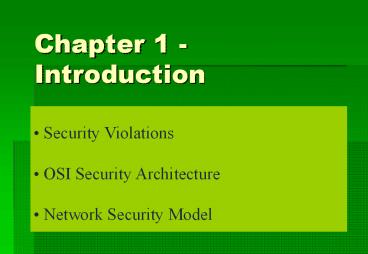Chapter 1 Introduction - PowerPoint PPT Presentation
Title:
Chapter 1 Introduction
Description:
Signature data tag to ensure. a) Source b) Integrity c) anti-forgery. Access Control ... Gatekeeper: password-based login, screening logic ... – PowerPoint PPT presentation
Number of Views:74
Avg rating:3.0/5.0
Title: Chapter 1 Introduction
1
Chapter 1 - Introduction
- Security Violations
- OSI Security Architecture
- Network Security Model
2
Security Violations
1. Capture
File F is SENSITIVE
F A -------gt
B C CAPTURES F
3
Security Violations
2. Intercept - Update
Authorisation File F is SENSITIVE A sends message
to B Update F with names A(m)
?m B(F) C INTERCEPTS m and adds
name of C A(m) ?m C(m) ?m
B(F)
4
Security Violations
3. Substitute
Authorisation File F is SENSITIVE C PRETENDS to
be A C sends message to B Update F with name
of C CA(m)
?m B(F)
5
Security Violations
4. Intercept - Preempt
A sends message to B STOP Cs r/w access
A(m0) ?m0 B(m1)
B(m1) ?m1
STOP(C) C INTERCEPTS m0 A(m0) ?m0
C ?m0 B(m1)
C(r/w ACCESS) B(m1)
?m1 STOP(C)
6
Security Violations
5. Denial
C sends message to B
C(m) ?m B Later, B
QUERIES C about message
B ?m,? C C DENIES
sending message C(m,?)
?NO B
7
OSI Security Architecture (X.800 Security
for Open Systems Interconnection)
- International Standard
- 5 Categories
- 14 Services
8
OSI Security Architecture Categories(services)
- Authentication (peer-entity, data-origin)
- Access Control
- Data Confidentiality (connection,
- connectionless, selective-field, traffic-flow)
- Data Integrity (connectionrecovery,
- no-recovery,
selective-field, - connectionlessno-recovery,selective-fi
eld) - NonRepudiation (origin, destination)
9
OSI Security Architecture
Authentication
Data Origin (m not protected)
A(m) ?m B
B(m,A) ? AUTHENTIC(A)? Peer Entity
A ?c? B
S(A,B) ? AUTHENTIC(A,B)?
S(c,masquerador,replay) ? SECURE(c)?
10
OSI Security Architecture Access
Control
Access REQUEST A(m)
?m Host/System Host MATCHES m
to A Host/System(m,A) ?m A A
GRANTED read/write access
c A(m)
?? Host/System
11
OSI Security Architecture
Confidentiality
CONNECTION
cK A ?? B
(e.g. TCP) CONNECTIONLESS
A ?mK B
SELECTIVE-FIELD
cKc A ??
B TRAFFIC-FLOW A
?? B
12
OSI Security Architecture
Integrity
CONNECTION-RECOVERY c
modification/destruction
A ?m B(m) ?recover ?
m CONNECTION-NO RECOVERY
c
modification/destruction A ?m
B(m) ?detect ? !! SELECTIVE
FIELD c
modification/destruction A ?mm
B(m) ?detect(m) ? !!
13
OSI Security Architecture
Non-Repudiation
SENDER VERIFICATION A ?m,A
B(m,A) ? m?A RECEIVER
VERIFICATION A ?m
B B ?m,B A(m,B) ?
m?B
14
OSI Security Architecture
Availability
- Upon request
- Denial of Service
- Attack Countermeasures
- Authentication
- Encryption
- Physical Response
15
SECURITY MECHANISMS (X.800) -
specific
- Encipherment unintelligible
- Signature data tag to ensure
- a) Source b) Integrity c)
anti-forgery - Access Control
- Data Integrity
- Authentication
- Traffic Padding prevent traffic analysis
- Routing Control adapt upon partial failure
- Notarization trusted third party
16
SECURITY MECHANISMS (X.800) -
pervasive
- Trusted Functionality
- Security Label
- Event Detection
- Audit Trail
- Recovery
17
ATTACKS
- PASSIVE
- System unaltered,
- hard to detect, easier to
prevent - ACTIVE
- System altered,
- easier to detect, hard to prevent
18
ATTACKS
- PASSIVE
- eavesdropping, monitoring,
- message release, traffic analysis
- ACTIVE
- replay,
masquerade(impersonation), - modification, denial of
service(supression,overload)
19
Model for Network Security
20
Model for Network Access Security
- Gatekeeper password-based login,
screening logic - Internal controls monitor activity, analyse
stored info































